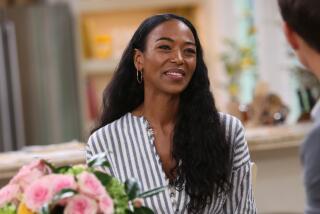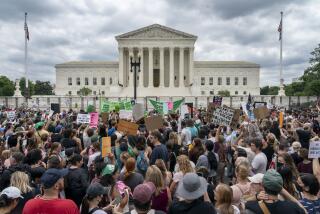Some Women Opt for Preventive Mastectomies
BOULDER, Colo. — In the end, the decision was easy.
After watching her mother struggle against breast cancer for 17 years, knowing that her grandmother, great-grandmother and four great-aunts all had died of the disease, Terri Giannetti--36 years old, married and childless--had her two healthy breasts cut off.
She also had her ovaries and uterus removed during those seven hours of surgery last September.
Gone forever is her chance to give birth. But so, too, is what she believed were the mortal threats of breast, ovarian and uterine cancer.
“I was sure I would get it, and now I have a huge sense of relief,” she said. “When you are going through such a traumatic decision, you have to have something to look forward to. So I looked forward to getting healthy, and staying alive.”
Statistically, one in nine women will develop breast cancer, and experts say a family history of the disease points to increased incidence in later generations.
Doctors now report a growing phenomenon, although exact numbers are not available: With the odds stacked against them, more and more women who have watched relatives succumb are choosing to have healthy breasts and reproductive organs removed.
“I’d spent almost a year researching the odds, talking to doctors--three oncologists and five surgeons--and I knew, in my heart, it was the right thing to do,” Terri said.
Now it’s her sister’s turn.
Early this year, Layne Hovey--35 years old, married and the mother of a young son--also will enter the hospital and have her healthy breasts, ovaries and uterus removed.
Like her sister, she believes her family’s terrible history of breast and ovarian cancer soon will catch up with her, trap her in its lethal genetic web.
Neither woman has treated her decision lightly, or failed to seek as much professional expertise as possible. Armed with a color-coded family tree dating back four generations, Terri, Layne and their sister Wendy--single, 31 years old--made rounds of specialists in Boulder and Denver, seeking advice.
“We’d walk in with our chart and the doctors would start nodding, saying ‘Yes, yes,’ and we knew we had their attention,” Layne said.
Dr. Russell Tolley, director of the Breast Clinic of the University of Colorado Health Sciences Center, took their case to a panel of 35 physicians who sit on University Hospital’s breast board.
“The board highly recommended we consider prophylactic mastectomies,” Layne said. “Doctors never tell you what to do, they just suggest options. But we could read between the lines.”
Scientists are convinced that some women are born with a greater risk of getting breast cancer, and at an earlier age, than other women. They also know that breast cancer travels through generations in some families, nearly wiping out whole clans of female relatives.
What they don’t know is why. There is no medical test to determine if a woman is predisposed toward breast cancer: The only way to find out is to carefully track her health and, if she is diagnosed, treat the disease early. By the time a woman is able to feel a lump in her breast, chances are it has been growing for up to 10 years.
Mammography can reveal a lump long before women, or their doctors, can feel it, and aggressive early treatment means better survival odds.
Dr. David Goldgar, a genetic epidemiologist at the University of Utah in Salt Lake City, is optimistic that researchers like his team will develop a diagnostic test for familial breast cancer within five years.
Research is zeroing in on a particular growth-enhancing gene, he said.
“You may need two or three hits to develop a malignancy but if you are born with the first hit, then maybe your lifetime risk will go from 10% to 80%, or even higher, if you inherited this gene,” Goldgar said.
Until there is a diagnostic test, the only thing “high risk” women can do--short of preventive removal--is to monitor their health and wait for the cancer to show up, if it ever does.
Terri, Layne, and Wendy all kept coming back to that family tree, with its slashes of yellow magic marker highlighting the names of all those dead women from the past.
Their mother was the most vivid example of what happens when breast cancer strikes. Alma Hovey of Harbor Springs, Mich., was diagnosed in 1974, had a mastectomy, and went on with her busy life. Six years later, she found a swollen node in her neck--the cancer had returned. She insisted that doctors remove her ovaries because she was afraid the disease would spread there too. Now there are tumors on her sternum, and elsewhere.
“Our mother is very spiritual, and she has a great deal of inner strength, so we have watched her trying very hard not to let this interfere with her life,” said Layne.
Layne’s gynecologist in Boulder was the first physician to raise the issue of preventive surgery.
“When she asked me a year ago if I had done any reading about familial cancer, my initial reaction was to laugh,” Layne said. “Here I was, chasing around a 3-year-old, juggling husband and job and child, worried about my mother, and just going along from day to day.
“But then we all talked about it, and we started making the rounds of doctors. All but one of them recommended we consider having surgery before we got cancer.”
For months, the sisters talked about little else, arguing, vacillating, “changing our minds constantly,” said Terri. They also discussed it with their mother.
“She told us that if she had known then what she knows now, she would have done it,” Terri said.
Dennis Giannetti told his wife: “I think this is the wise thing for you to do, because I want you to live.” But for months, Terri tested her husband’s reaction to the looming reality that they would never have a biological child together once she had her reproductive organs removed.
“Finally, Dennis said to me one day that if we did have a child, and it was a girl, we would likely pass this terrible thing on to her and she would have to go through all this in her life, and was that fair? That sort of clinched it for me,” Terri said.
Layne is glad her only child is a son, and not a daughter who would be vulnerable to the family plague.
“We sisters feel like we are nipping this in the bud,” she said. “In a way it’s sad, because our family heritage ends with the three of us, and my son Mattson. But at least we won’t be passing on any more breast or ovarian cancer to our children.
“Our husbands have been in the back seat with our Mom throughout her illness, and nobody who loves you would want you to go through what she’s been through if there is the remotest chance of preventing this living hell.”
Insurance companies for both women agreed to cover the $30,000 cost of each preventive operation and reconstructive plastic surgery. That made the decisions easier, they said.
“For a woman 36 years old, without children, there is a lot of peer pressure against what I did, because all the people you socialize with are having babies,” Terri said. “But my friends were very supportive, and although Dennis and I don’t have children, that doesn’t mean we won’t adopt.
“And now I feel great, happy, ready for the future. Fear is no longer hanging over my head.”
Layne says she, too, is ready to put the surgery behind her and get on with her life after the surgery in late January or early February. And both sisters believe Wendy ultimately will decide to follow their course.
“These are hard choices to make, especially right now when she is single,” Layne said. “Because she is only 31, she has a little more time to make them. But she knows the risk factor. She’s on the family tree, just like we are.
“Some people have said to me, ‘You have become so cold about this, so matter-of-fact,”’ she added, “but we have to be. Being a woman in this family means dying of breast cancer. We cannot stick our heads in the sand. That is our reality.”






